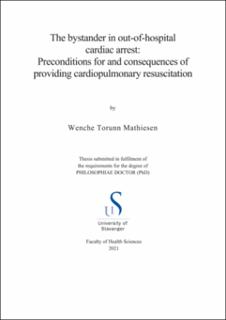| dc.contributor.advisor | Bjørshol, Conrad | |
| dc.contributor.advisor | Søreide, Eldar | |
| dc.contributor.author | Mathiesen, Wenche Torunn | |
| dc.date.accessioned | 2020-09-02T19:46:25Z | |
| dc.date.available | 2020-09-02T19:46:25Z | |
| dc.date.issued | 2020-06 | |
| dc.identifier.citation | The bystander in out-of-hospital cardiac arrest: Preconditions for and consequences of providing cardiopulmonary resuscitation by Wenche Torunn Mathiesen.Stavanger : University of Stavanger, 2020 (PhD thesis UiS) | en_US |
| dc.identifier.isbn | 978-82-7644-952-5 | |
| dc.identifier.issn | 1890-1387 | |
| dc.identifier.uri | https://hdl.handle.net/11250/2676110 | |
| dc.description.abstract | Background: Out-of-hospital cardiac arrest (OHCA) is a major cause for death in the Western world. To optimise survival after OHCA incidents, health care systems depend on bystanders, who are not a part of an organised response system, to alarm the emergency medical dispatch centre and initiate cardio-pulmonary resuscitation (CPR). However, there is sparse knowledge on the preconditions that make bystanders actually perform CPR, the consequences of performing CPR for the bystanders themselves and how bystander CPR influences survival in rural and urban areas.
Aims: The aims of the current thesis were as follows: 1) to acquire more knowledge from the bystander’s perspective regarding their preparedness and the consequences of CPR provision in OHCA incidents and 2) to measure the effect of bystander CPR on patient outcomes in rural and urban areas.
Methods: The project comprises qualitative and quantitative methodologies applied in four studies. In both qualitative studies, we used semi-structured in-depth interviews to interview bystanders who had provided CPR to OHCA victims. We used a qualitative content analysis for analysing the data. The quantitative methods entailed a cross-sectional survey and an observational registry study. The data were analysed with several statistical techniques.
Results: We found that most participants were prepared to receive CPR instructions from the dispatcher, but not aware of the assistance given in deciding whether to initiate CPR or not. Acting as responsible community citizens, trusting assistance from dispatchers, possessing the willingness and ability to provide CPR and being able to comprehend the severity of the OHCA incident were factors important for overcoming barriers to providing CPR. However, providing CPR was emotionally challenging for the bystanders, with consequences for both family and work life. Bystanders who had provided CPR described alsopersistent mental recurrences concerning the outcome of the cardiac arrest victim and unknown or fatal outcomes caused feelings of guilt and were particularly difficult to handle. In patients who received bystander CPR before EMS arrival, the odds of survival to hospital discharge increased more than threefold. However, bystander CPR was associated with survival only for patients in urban areas. OHCA survival was higher in urban compared to rural areas, and the effect of modifiable factors, like bystander CPR, differed between urban and rural areas. Conclusion: In OHCA incidents, a mutual trust between community citizens and social institutions seems to be a precondition for bystander CPR provision. To overcome the natural reluctance to provide CPR, support and instructions from emergency medical dispatchers is of vital importance. This support is expected by the public, particularly in the form of CPR instructions. When bystanders establish a causal relationship between the provided CPR and patient outcome, this may cause serious and persistent distress. We also found that bystander CPR drastically increases the chance of survival in OHCA incidents. However, the effect of bystander CPReems to differ between rural and urban areas. | en_US |
| dc.language.iso | eng | en_US |
| dc.publisher | Stavanger: Universitetet i Stavanger | en_US |
| dc.relation.ispartofseries | PhD thesis UiS; | |
| dc.relation.haspart | Paper 1: Mathiesen WT, Birkenes T, Lund H, Ushakova A, Søreide E, Bjørshol CA, Public knowledge and expectations to dispatcher assistance in out-of-hospital cardiac arrest. Submitted to Journal of Advanced Nursing, 19-Apr-2018, JAN-2018-0403 | en_US |
| dc.relation.haspart | Paper 2: Mathiesen WT, Bjørshol CA, Høyland S, Braut GS, Søreide E (2017) Exploring How Lay Rescuers Overcome Barriers to Provide Cardiopulmonary Resuscitation: A Qualitative Study. doi.org/10.1017/S1049023X16001278, Prehospital and Disaster Medicine 1-6. This paper is not in Brage due to copyright. | en_US |
| dc.relation.haspart | Paper 3: Mathiesen WT, Bjørshol CA, Braut GS, Søreide E (2016) Reactions and coping strategies in lay rescuers who have provided CPR to out-of-hospital cardiac arrest victims: a qualitative study. doi.org/10.1136/bmjopen-2015-010671, BMJ open 6.5 | en_US |
| dc.relation.haspart | Paper 4: Mathiesen WT, Bjorshol CA, Kvaloy JT, Soreide E. Effects of modifiable prehospital factors on survival after out-of-hospital cardiac arrest in rural versus urban areas. Critical care. 2018;22(1):99. Epub 2018/04/20. | en_US |
| dc.subject | CPR | en_US |
| dc.subject | HLR | en_US |
| dc.subject | hjerte-lungeredning | en_US |
| dc.subject | hjerteinfarkt | en_US |
| dc.title | The bystander in out-of-hospital cardiac arrest: Preconditions for and consequences of providing cardiopulmonary resuscitation | en_US |
| dc.type | Doctoral thesis | en_US |
| dc.rights.holder | © Wenche Torunn Mathiesen 2020 | en_US |
| dc.subject.nsi | VDP::Medisinske Fag: 700 | en_US |
